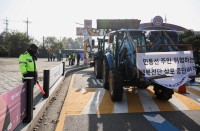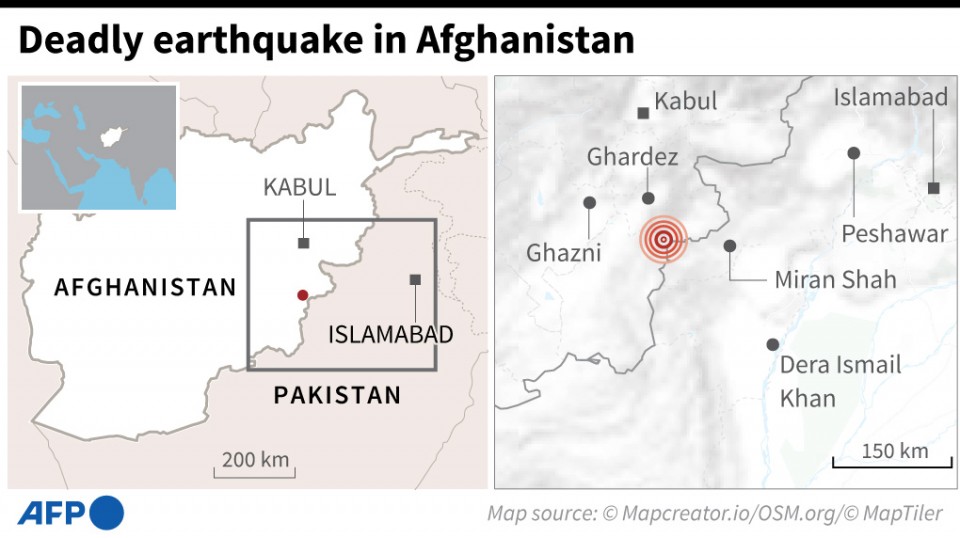KABUL, June 22, 2022 (AFP)
A powerful earthquake struck a remote border region of Afghanistan overnight killing at least 920 people and injuring hundreds more, officials said Wednesday, with the toll expected to rise as rescuers dig through collapsed dwellings.
The 5.9 magnitude quake struck hardest in the rugged terrain of the east, where people already live hardscrabble lives in a country in the grip of a humanitarian disaster made worse by the Taliban takeover in August.
#Breaking: The death toll from Tuesday night’s earthquake jumps to 920 people.
Deputy State Minister for Natural Disaster Management Mawlavi Sharfuddin Muslim in a press conference today said that 920 people were killed & 610 others injured in the quake.#Earthquake #Afghanistan pic.twitter.com/QE4rdesWFV— Bakhtar News Agency (@BakhtarNA) June 22, 2022
A powerful earthquake struck a remote border region of Afghanistan overnight killing at least 920 people and injuring hundreds more, officials said Wednesday, with the toll expected to rise as rescuers dig through collapsed dwellings.
The 5.9 magnitude quake struck hardest in the rugged terrain of the east, where people already live hardscrabble lives in a country in the grip of a humanitarian disaster made worse by the Taliban takeover in August.
The death toll has climbed steadily all day as news of casualties filtered in from hard-to-reach areas in the mountains, and the country’s supreme leader, Hibatullah Akhundzada, warned it would likely rise further.
“So far the information we have is that at least 920 people have been martyred and 600 injured,” Sharafuddin Muslim, the deputy minister for disaster management, told a press conference in the capital, Kabul.
Earlier, a tribal leader from Paktika province — one of the hardest hit areas — said survivors and rescuers were scrambling to help those affected.
“The local markets are closed and all the people have rushed to the affected areas,” Yaqub Manzor told AFP by telephone.
Photographs and video clips posted on social media showed scores of badly damaged mud houses in remote rural areas.
Some footage showed local residents loading victims into a military helicopter.
Even before the Taliban takeover Afghanistan’s emergency response teams were stretched to deal with the natural disasters that frequently struck the country.
But with only a handful of airworthy planes and helicopters, an immediate response is often limited.
“The government is working within its capabilities,” tweeted Anas Haqqani, a senior Taliban official.
“We hope that the International Community & aid agencies will also help our people in this dire situation.”
The United Nations and European Union were quick to offer help.
“Inter-agency assessment teams have already been deployed to a number of affected areas,” the UN Office for the Coordination of Humanitarian Affairs (UNOCHA) in Afghanistan tweeted.
Tomas Niklasson, EU special envoy for Afghanistan, tweeted: “The EU is monitoring the situation and stands ready to coordinate and provide EU emergency assistance to people and communities affected.”
Afghanistan is frequently hit by earthquakes — especially in the Hindu Kush mountain range, which lies near the junction of the Eurasian and Indian tectonic plates.
Scores of people were killed and injured in January when two quakes struck rural areas in the western province of Badghis, damaging hundreds of buildings.
In 2015, more than 380 people were killed in Pakistan and Afghanistan when a 7.5-magnitude earthquake ripped across the two countries, with the bulk of the deaths in Pakistan.
The latest earthquake came at a time when Afghanistan is battling a severe humanitarian disaster, worsened by the Taliban takeover of the country.
Aid agencies and the United Nations say Afghanistan needs billions of dollars this year to tackle the crisis.
Aid agencies have particularly stressed the need for greater disaster preparedness in Afghanistan, which remains extremely susceptible to recurring earthquakes, floods and landslides.
The quake was felt as far away as Lahore in Pakistan, 480 kilometres (300 miles) from the epicentre, according to responses posted on the USGS and European Mediterranean Seismological Centre (EMSC) websites.
© Agence France-Presse









